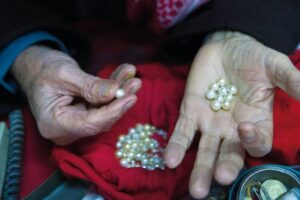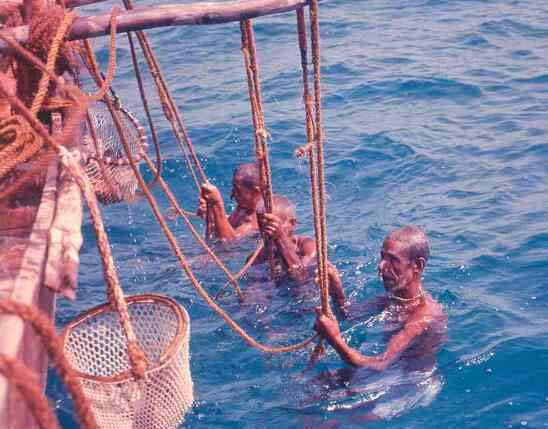MANAMA (Bahrain) – Different pearls of unmatched quality and colours were placed orderly on the shelves of the Bahrain Institute for Pearls and Gems, widely known as DANAT, Bahrain’s most important pearl appraising centre.
Each of the pearls placed on the shelves tells the story of its fishing and its position over time.
Pearl fishing and extraction were the prime economic activity of the people of Bahrain, before the discovery of oil in the early 1930s.
With this glorious past in the background, Bahrain now aspires to become a global centre for sustainable pearls.
The history of pearls in Bahrain dates 4,000 years back. This Arab Gulf nation continues to lead the way as far as international pearl production is concerned.
Bahraini pearls are known for their quality features. The layers of their nacre, their shape, body colour, overtone colour, their polish and surface blemishes are always different from pearls coming from other countries.
Bahrainis dived freely for centuries to collect pearl oysters from the sea floor.
Some Bahrainis continue to preserve this tradition until the present. They are also part of the pearls’ trade, including pearl trader Abbas Ibrahim.
“Most Bahrainis were associated with pearl fishing, extraction and the pearl trade for centuries before the discovery of oil,” Ibrahim told the Egyptian Mail.

Ibrahim’s shop is located in Muharraq Central Market, the oldest shopping centre in the capital Manama.
He described the natural pearl business as a ‘tough’ trade, due to the rarity of the star element.
In 2012, UNESCO declared the Bahraini pearl beds a World Heritage site.
It described the region as the last remaining complete example of the cultural tradition of pearl fishing and extraction.
Bahrain’s location as an island in the middle of the trade route between Iraq and India helped make it a pearl trade hub.
Some marine biologists believe that the convergence of saltwater with fresh natural springs in the middle of the Gulf creates a unique environment for pearls to grow with high lustre.
The value of natural pearls plummeted after the advent of cultured pearls in Japan in the early 1900s.
However, the gems are experiencing a renaissance as consumers look for more responsibly sourced jewellery and one-of-a-kind pieces.
Natural pearls form when a foreign object, such as a grain of sand, or parasite, finds its way inside a pearl oyster.
To protect itself, the oyster produces an iridescent mineral substance to engulf the object.
With natural pearls forming in only 1 in 10,000 oysters and each one growing organically over several years into a unique shape, every natural pearl is both rare and inimitable.
Unlike pearls cultivated in farms, a process which often involves deliberately inserting a foreign object (usually a bead) into the oyster, Bahrain’s natural pearls develop without any human interference.
Noora Jamsheer, the CEO of DANAT, said the collection of the pearls is usually done in the least obtrusive way.
“This happens with licensed divers carefully gathering oysters by hand,” she told the Egyptian Mail.
DANAT was established in 2017 to oversee the implementation of the national plan for the revival of the pearl sector.
The institute monitors and shields the health of the pearl beds, periodically suspending diving in certain areas to allow growth, in collaboration with the Supreme Council for the Environment and the Coast Guard.
It tests and certifies the pearls and offers hands-on pearl grading education.
The institute also offers Bahraini biologists and physics specialists training to develop devices to be used in pearl testing labs.
Bahrain’s natural pearl market witnesses steady growth, recuperating from the toll Covid-19 has had on it.
There was a significant growth in the number of pearl diving licenses, including ones issued female pearl divers, in 2021, according to DANAT.
“The luxury market bounced back in 2021,” Jamsheer said.
This, she added, especially happened in the sector of ultra-luxury, extremely exclusive, and rare products, including natural pearls.
Nevertheless, the natural pearl market faces challenges, the gravest of which are cultured pearls, according to a DANAT expert.
The prices of natural pearls, he said, collapsed after the advent of cultured pearls in Japan, an event that was followed by the Great Depression in the 1930s.
To the untrained eye, cultured pearls are indistinguishable from natural ones.
With natural pearls making millions at auctions and their cultured counterparts available for as little as $50, it is easy to see why consumers would opt for the perfect imitation.
DANAT participates in many international exhibitions to showcase Bahraini pearl heritage.
The institute launched the first DNA fingerprint report on coral reefs to determine the type of mollusc and the source of pearls.
In addition to showing details of the type and species of corals through DNA analysis and a comprehensive analysis of chemical elements, DANAT came up with a technology that facilitates the appraisal of pearls, including their composition from the inside in three dimensions through radiography.
Most of the pearls found in Bahrain are seed ones. They are small pearls used in intricate jewellery designs and high fashion garments.
“They have a particularly nice appearance,” Jamsheer said.
Bahraini seed pearls are back in demand as new jewellery houses emerge and established jewellers start to reimagine natural pearls in contemporary designs.
“Our biggest goal is to educate the world on the alluring beauty of natural pearls, especially Bahraini pearls, by introducing new concepts and creating world class jewellery that instils the love of this gem,” Jamsheer said.






Discussion about this post